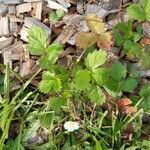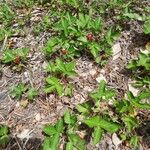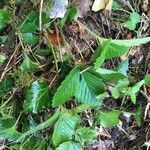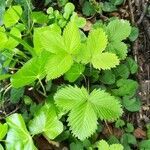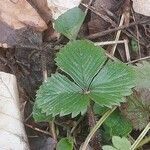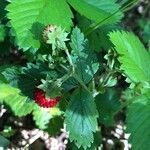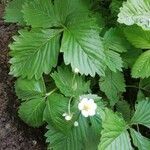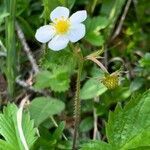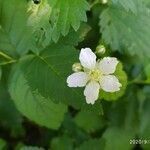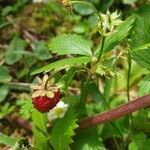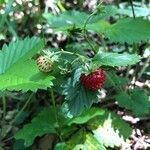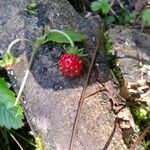Lfls sessile or nearly so, ovate to obovate, ± silky beneath, bright green or somewhat yellowish-green, thin, often bulging on the upper side between the principal lateral veins, these diverging from the midrib at an angle of ca 45°, the teeth sharp and rather divergent, the terminal tooth more than half as wide as the adjacent lateral ones and (equaling or) projecting beyond them; peduncles at anthesis usually shorter than the lvs, later surpassing them; pedicels unequal and commonly proliferous, the infl eventually racemiform or paniculiform; pet 5–7 mm; 2n=14. Europe and N. Amer. Apr.–June. The chiefly European var. vesca, with ovoid or subglobose fr and with the long hairs of the petioles and peduncles widely spreading or even retrorse, is widely intr. in our range, and thought to be native in se. Can. Var. americana Porter, native from Nf. to Man., s. to Va., Ind., and Neb., has slenderly ovoid or ellipsoid fr, and the long hairs of the petioles and peduncles are ascending or appressed.
A tufted perennial, emitting from a central rootstock long stolons rooting at the nodes and forming new plants.. Stipules red-brown, papery.. Leaves petiolate, trifoliolate; leaflets ovate, oblong, or oblong-ovate, 3–4 × 2–3 cm., obtuse, basally cuneate to ± truncate, sharply serrated with rather few acute and large teeth, green above, with a few appressed hairs or glabrous, whitish below with silky appressed hairs; petiole densely covered with spreading, silky hairs, commonly 3–6 (but up to 25) cm. long; petiolules very short, the leaflets often subsessile.. Inflorescence an erect, leafless cyme bearing about 5 flowers; flowering stems up to 15 cm. tall, hairy as the petioles.. Flowers 12–18 mm. diameter.. Calyx covered externally with appressed silky hairs; calyx-lobes ovate, acuminate, about 2.75 mm. long; epicalyx-lobes oblong, acute, nearly equalling the calyx-lobes.. Petals white, obovate, ± 4 mm. long.. Fruit ovoid or spherical, nodding and red or reddish when ripe.
Herbs perennial, 5–30 cm tall. Stems together with petioles spreading pilose, rarely glabrescent. Petiole 3–20 cm; leaf blade 3-foliolate, rarely pinnately 5-foliolate; leaflets sessile or central one shortly petiolulate, abaxially greenish, adaxially green, obovate, elliptic or broadly ovate, 1–5 × 0.6–4 cm, abaxially pubescent or sometimes glabrescent, adaxially sparsely pubescent, base cuneate or broadly so, margin obtusely or acutely incised serrate, apex obtuse. Inflorescence corymbiform, 2–4(or 5)-flowered, with a greenish, subulate or petiolate, leafletlike bract. Pedicel 1–3 cm, appressed pilose. Sepals ovate-lanceolate, apex caudate; epicalyx segments linear-lanceolate or subulate, shorter than sepals. Petals white, obovate, base tapering into a short claw. Stamens ca. 20, unequal. Carpels numerous. Aggregate fruit ripening red, ovoid. Achenes ovoid, not prominently rugose. Fl. Apr–Jun, fr. Jun–Sep. 2n = 14.
Perennial, stoloniferous herb, 0.1-0.2 m high; branches decumbent, plant parts sericeous. Leaves: cauline ones in a rosette, 3-foliolate, pinnae ovate, obovate or rhombic, coarsely serrate, margins deeply crenate-serrate, chartaceous or subcoriaceous, sparsely hairy on upper surface, lower surface sparsely sericeous; distal leaves 3-foliolate or rarely simple and reduced. Stipules scarious, reddish brown. Inflorescence with 2-7 or rarely solitary flowers; floral bracts 3-7 mm long. Flowers: hypanthium patelliform; episepal narrowly ovate, entire or bifid; sepals ovate; petals broadly obovate to suborbicular, apex rounded, glabrous; stamens 20-25; anthers ovate-oblong; carpels 100; ovary glabrous; style 0.8-1.0 mm long, stigma 0.1-0.2 mm in diam. Flowering time Apr. Fruit: receptacle ovoid-globose; achenes hemispheric to slightly ovoid. Seeds hemispheric-ovoid.
Plants hermaphroditic (sometimes pistillate in subsp. bracteata). Leaves bright green (sometimes darker green in subsp. californica), not glaucous, thin, not leathery, not reticulately veined abaxially, terminal tooth of terminal leaflet longer than or equal to adjacent teeth (sometimes equal to or shorter than adjacent teeth in subsp. californica). Flowers bisexual or unisexual; hypanthium 11–21.2 mm diam.; petals 5, ± obovate to nearly orbiculate, margins overlapping or distinct. Achenes deeply embedded, in shallow pits, or superficial, yellowish green to reddish brown, 1–1.5 mm; bractlets and sepals clasping, spreading, or reflexed in fruit; torus easily or not easily separating from hypanthium.
A small plant which keeps growing from year to year. It grows to 20 cm high and spreads to 30 cm wide. The stems are long runners which form roots at the nodes. The leaves have 3 leaflets and are bright green. The leaflets are oval and with coarse teeth around the edge. They are 6 cm long and arranged in rings on long leaf stalks. The flowers are small white and open. They have 5 petals. The fruit are oval and fleshy. They are white and turn red (or white) as they ripen. They are sweet. A strawberry with small leaves and fruit and the seeds are on the outside of the fruit.
Leaflets 1.5-3 by 1-2.5 cm, terminal petio-lule 0-l(-2) mm. Hypanthium 2.5-3 mm diam. Epicalyx leaves and sepals 3-4 mm long. Petals 4-6 aim long. Stamens 20 or less. Spurious fruits obovoid, up to c. 1.5 by 1 cm, achenes not sunken in fleshy torus.
Perennial herb with long, epigeal, rooting stolons. Leaves 3-foliolate in basal rosette. Pedicels appressed-pubescent. Achenes projecting, uniformly scattered over receptacle. Flowers white.
